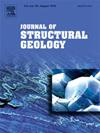Strain localization in quartzo-feldspathic mylonites from Patos shear zone revealed by EBSD data
IF 2.9
2区 地球科学
Q2 GEOSCIENCES, MULTIDISCIPLINARY
引用次数: 0
Abstract
Understanding how strain is localized and concentrated in the mid-crust is critical to geological research. Investigating the microstructure and texture of quartzo-feldspathic mylonites is essential in this context. The Patos shear zone (PSZ), stretching ∼600 km long and responsible for the deformation of the paleoproterozoic basement in the Borborema Province under varying temperature conditions, is a significant shear zone for exploration. Combining techniques, including optical and scanning electron microscopy and Electron Backscatter Diffraction (EBSD) our research focused on quartzo-feldspathic mylonites to comprehend the solid-state processes responsible for strain localization within the Patos shear zone. As materials undergo uplift and deformation transition from a submagmatic to a solid-state flow, strain is concentrated within increasingly narrow zones. Our results demonstrated that after melt solidification, biotite-rich layers at temperatures exceeding 650 °C become weaker domains that accommodate strain through dislocation creep in feldspar, biotite and to a lesser extent in quartz, with the activation of prism-[c] slip system. During late reactivation, under upper greenschist/lower amphibolite facies, dislocation creep, strain-induced myrmekitization, solution-precipitation mechanisms are the dominant mechanisms for grain-size reduction in feldspar, with the resulting fine-grained matrix deforming via dislocation-accommodated and fluid-assisted grain boundary sliding (GBS). Quartz undergoes recrystallization as it transitions from grain boundary migration to subgrain rotation, with the activation of prism-<a> slip system. At temperatures below 450 °C, in the southern Patos shear zone, quartz ribbons experience bulging recrystallization with the activation of prism-<a> and rhomb<a> slip systems. Feldspar porphyroclasts undergo fracturing, myrmekitization and dissolution-precipitation creep. Rock rheology is controlled by fine-grained polyphase aggregates deforming via Dislocation-accommodated GBS. Finally, our study highlights the role of discontinuities during low-temperature deformation, such as the contact between rheologically contrasting layers and transgranular fractures, which serve as a precursor that led to shear zones nucleation in the northern block of the Patos shear zone.
基于EBSD数据的Patos剪切带石英长石糜棱岩应变局部化研究
了解应变如何局部化和集中在中地壳是地质研究的关键。在这种情况下,研究石英长石糜棱岩的微观结构和结构是必不可少的。Patos剪切带(PSZ)长约600 km,是borborrema省古元古代基底在变温条件下变形的原因,是一个重要的剪切带。结合光学、扫描电镜和电子背散射衍射(EBSD)等技术,我们的研究重点是石英长石糜棱岩,以了解在Patos剪切带内负责应变局部化的固态过程。随着物质从岩浆下流动到固态流动的抬升和变形转变,应变集中在越来越窄的区域内。我们的研究结果表明,熔体凝固后,在超过650℃的温度下,富含黑云母的层通过长石、黑云母和石英中的位错蠕变而成为适应应变的较弱域,并激活了棱镜-[C]滑移系统。在再激活后期,在绿片岩相上部/角闪岩相下部,位错蠕变、应变诱导的甲基化作用和固溶沉淀机制是长石晶粒减小的主要机制,导致细晶基体通过位错调节和流体辅助晶界滑动(GBS)发生变形。石英在晶界迁移到亚晶旋转的过程中发生再结晶,棱柱活化-<;a>;滑系统。当温度低于450℃时,在Patos剪切带南部,石英带随着棱柱的激活发生胀形再结晶。和rhomb< a>滑系统。长石卟啉碎屑经历破碎、矿化和溶蚀-沉淀蠕变。岩石流变是由由位错调节的GBS变形的细粒多相聚集体控制的。最后,我们的研究强调了低温变形过程中不连续的作用,例如流变对比层与穿晶裂缝之间的接触,这是导致Patos剪切带北块体剪切带成核的前体。
本文章由计算机程序翻译,如有差异,请以英文原文为准。
求助全文
约1分钟内获得全文
求助全文
来源期刊

Journal of Structural Geology
地学-地球科学综合
CiteScore
6.00
自引率
19.40%
发文量
192
审稿时长
15.7 weeks
期刊介绍:
The Journal of Structural Geology publishes process-oriented investigations about structural geology using appropriate combinations of analog and digital field data, seismic reflection data, satellite-derived data, geometric analysis, kinematic analysis, laboratory experiments, computer visualizations, and analogue or numerical modelling on all scales. Contributions are encouraged to draw perspectives from rheology, rock mechanics, geophysics,metamorphism, sedimentology, petroleum geology, economic geology, geodynamics, planetary geology, tectonics and neotectonics to provide a more powerful understanding of deformation processes and systems. Given the visual nature of the discipline, supplementary materials that portray the data and analysis in 3-D or quasi 3-D manners, including the use of videos, and/or graphical abstracts can significantly strengthen the impact of contributions.
 求助内容:
求助内容: 应助结果提醒方式:
应助结果提醒方式:


